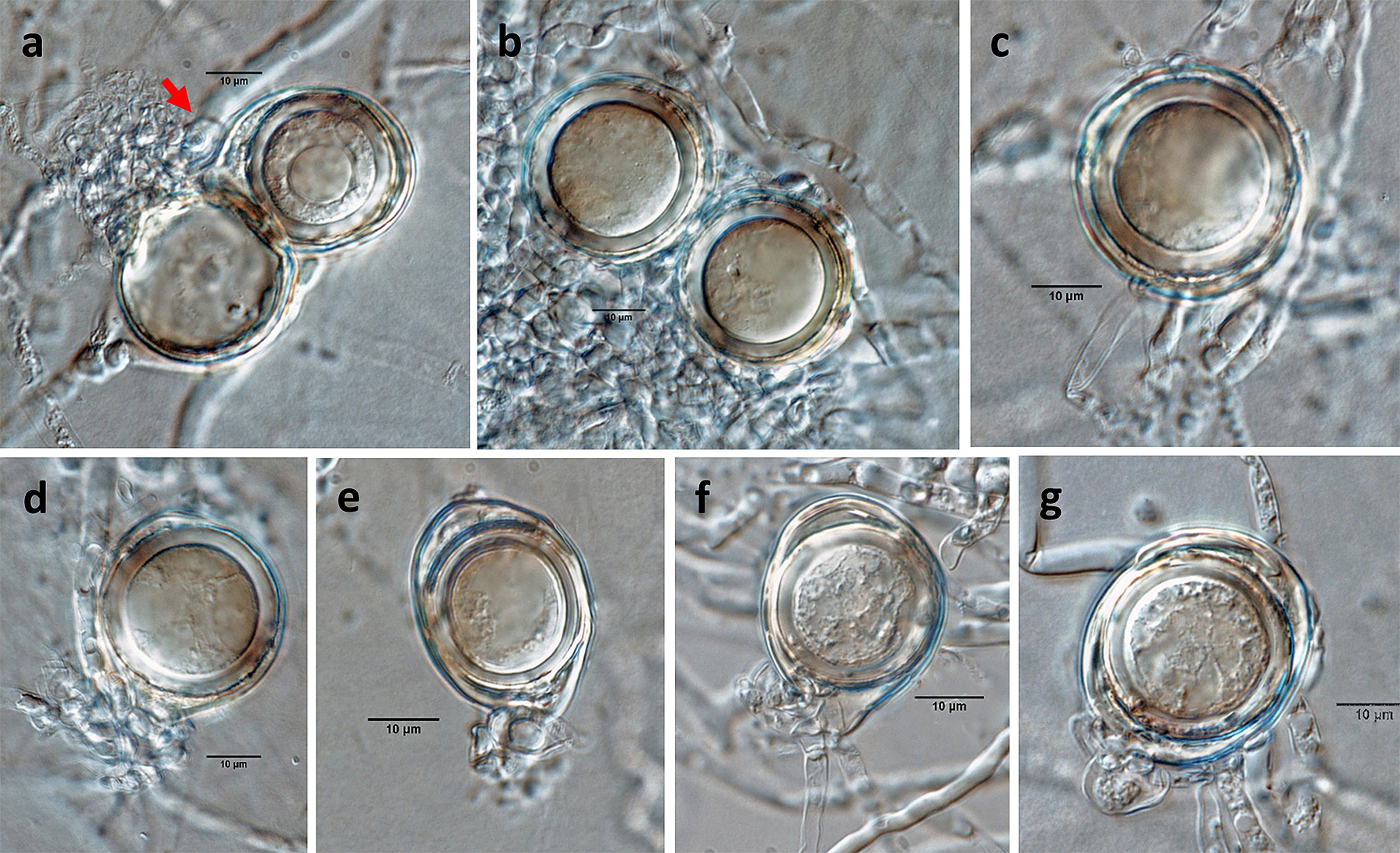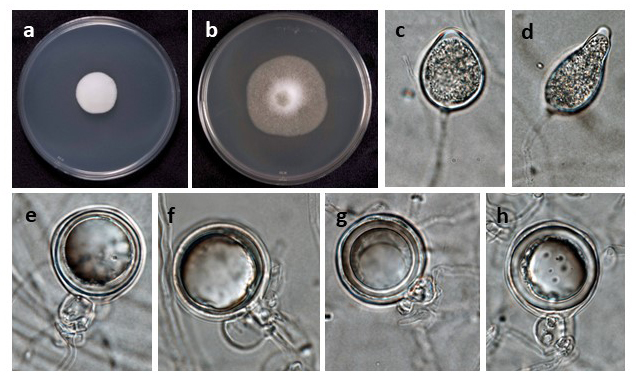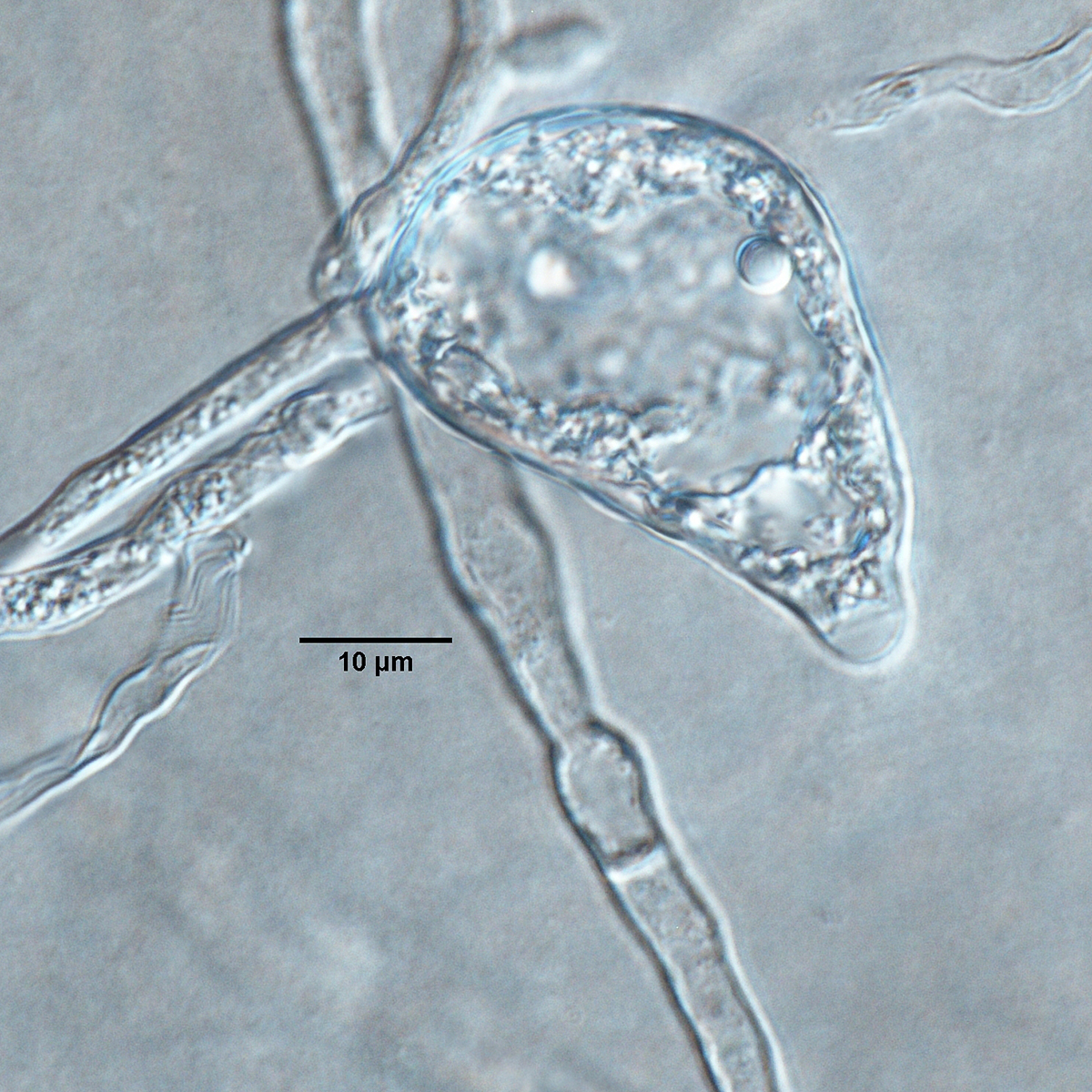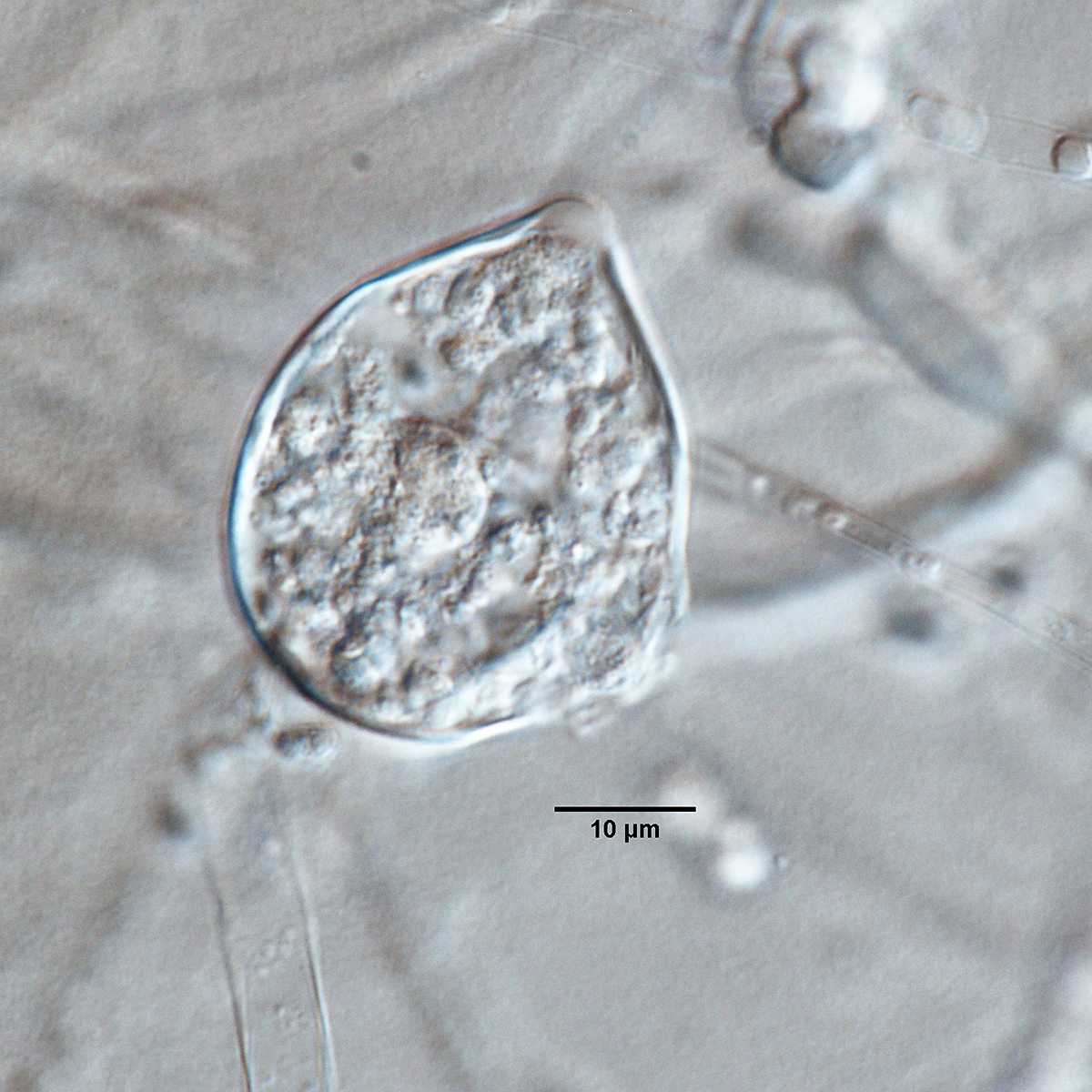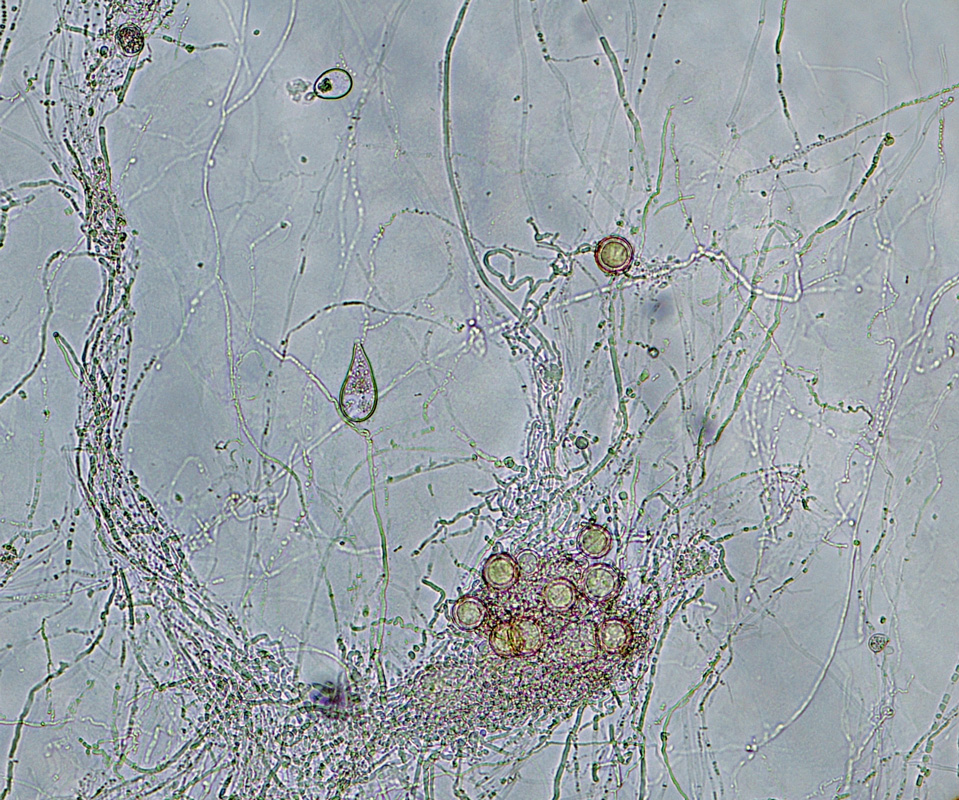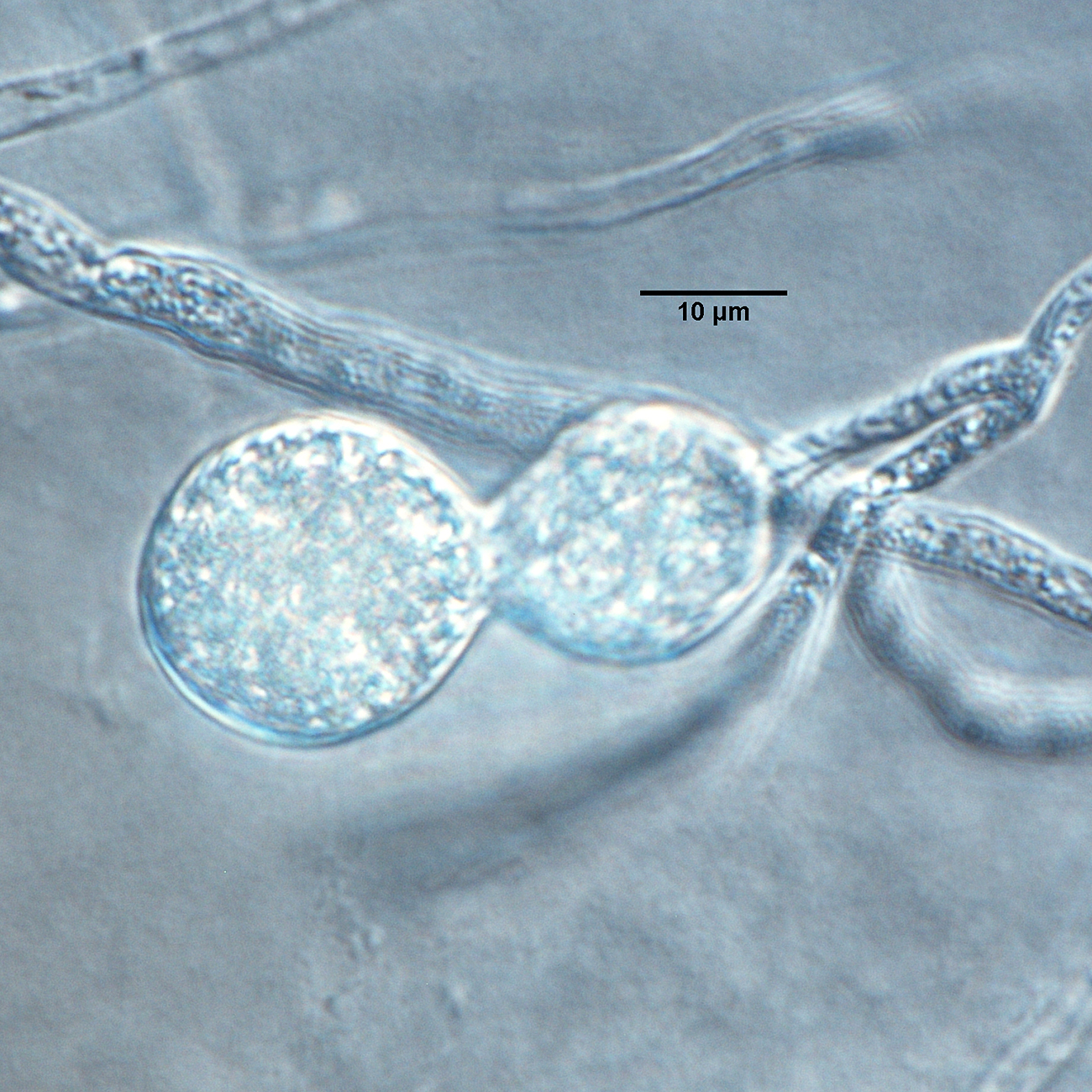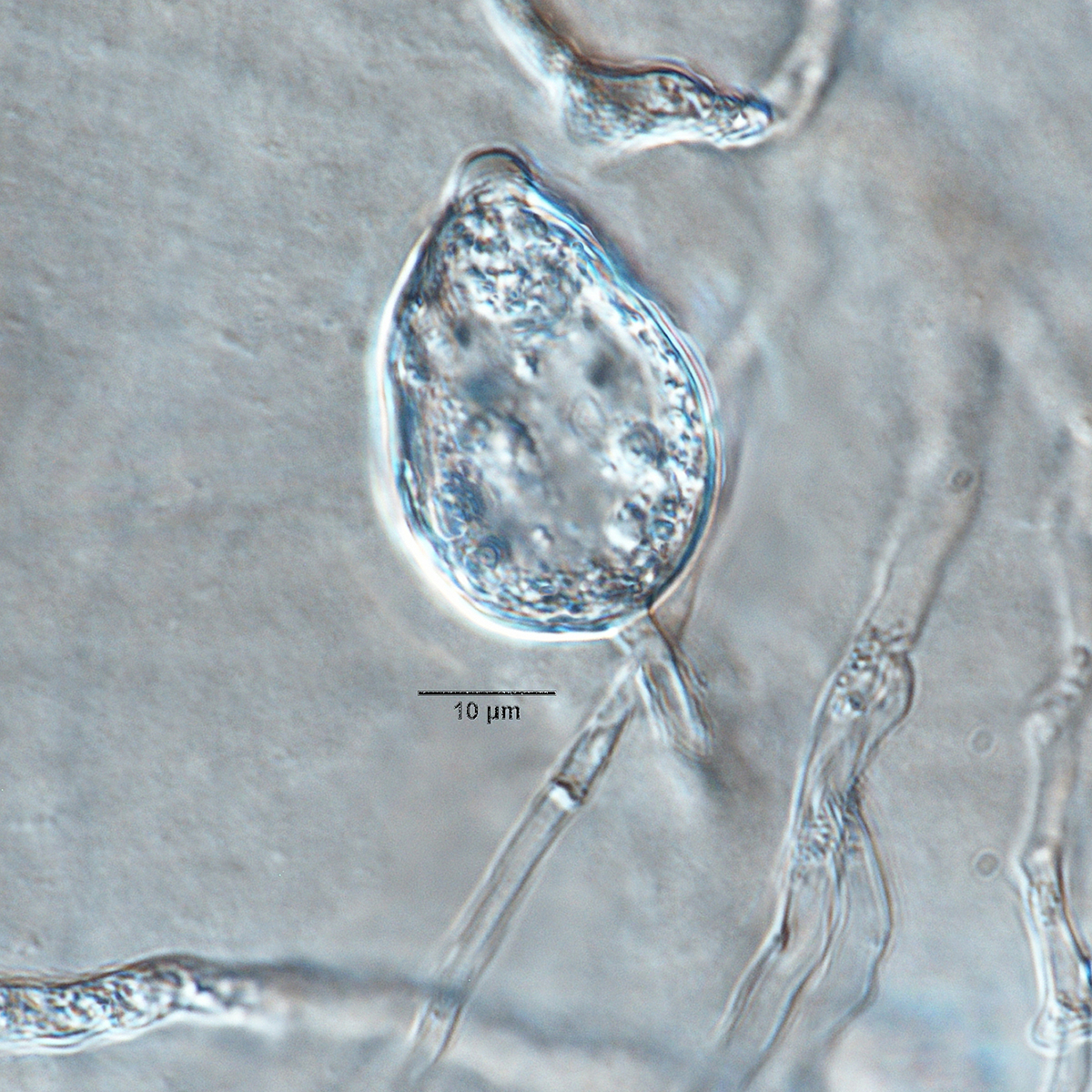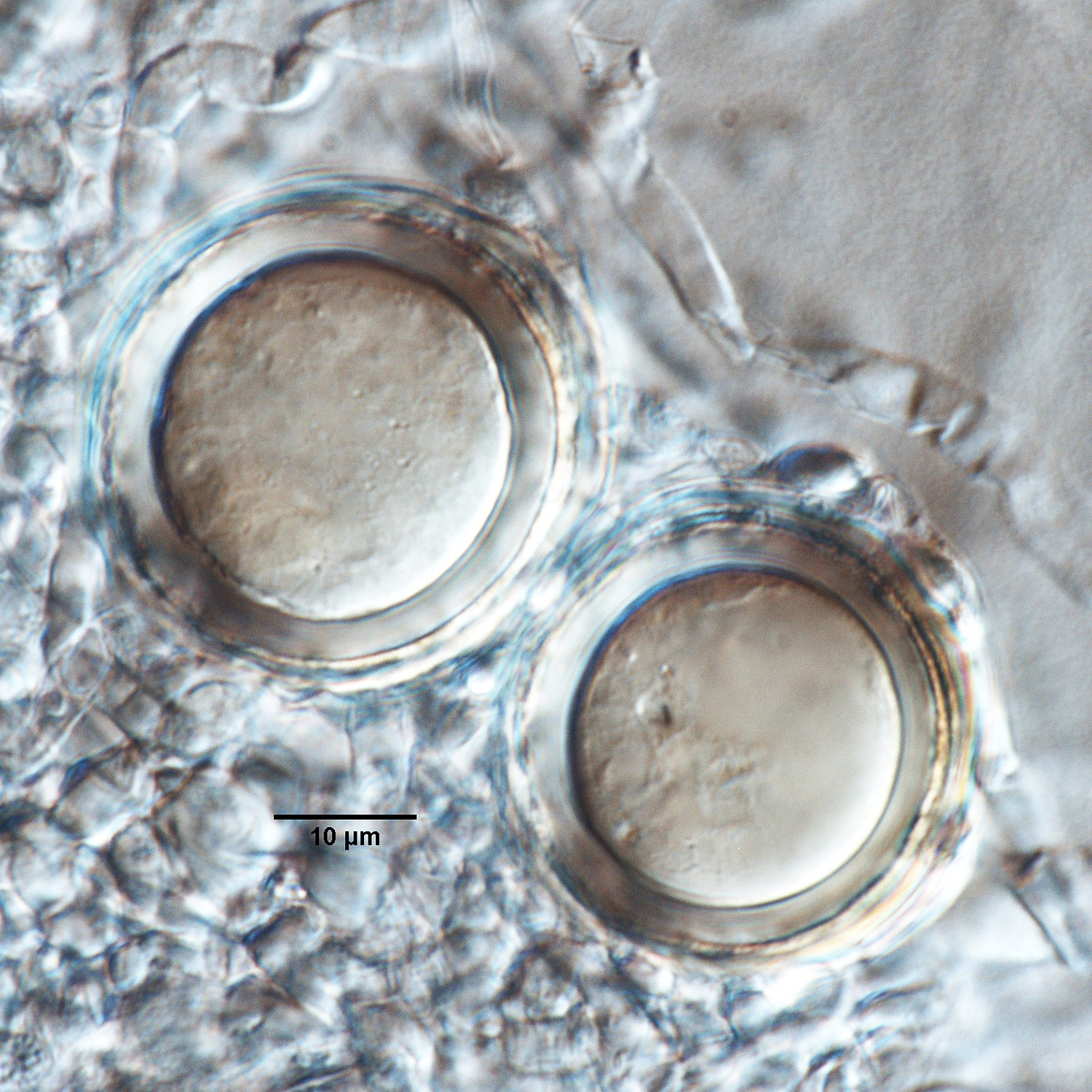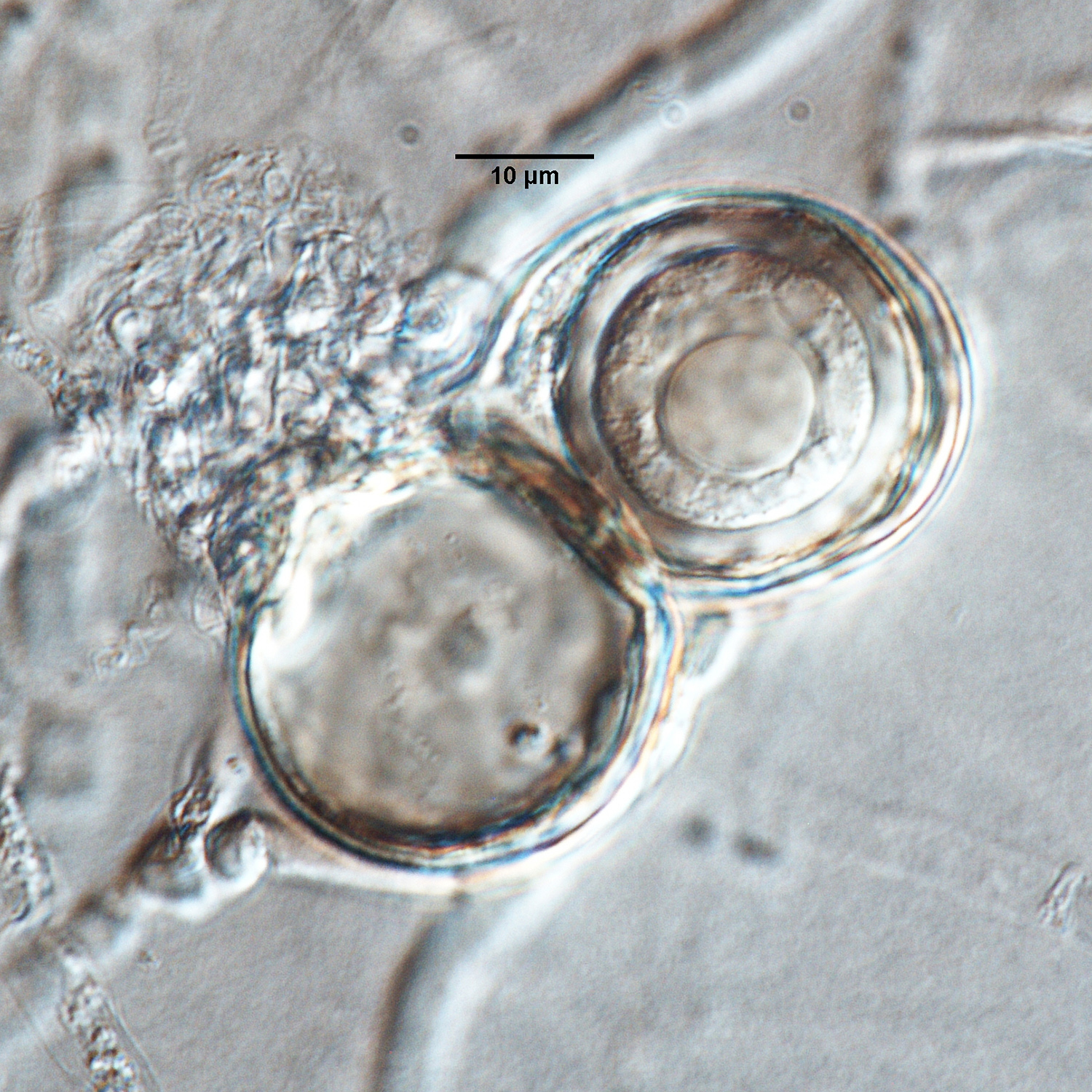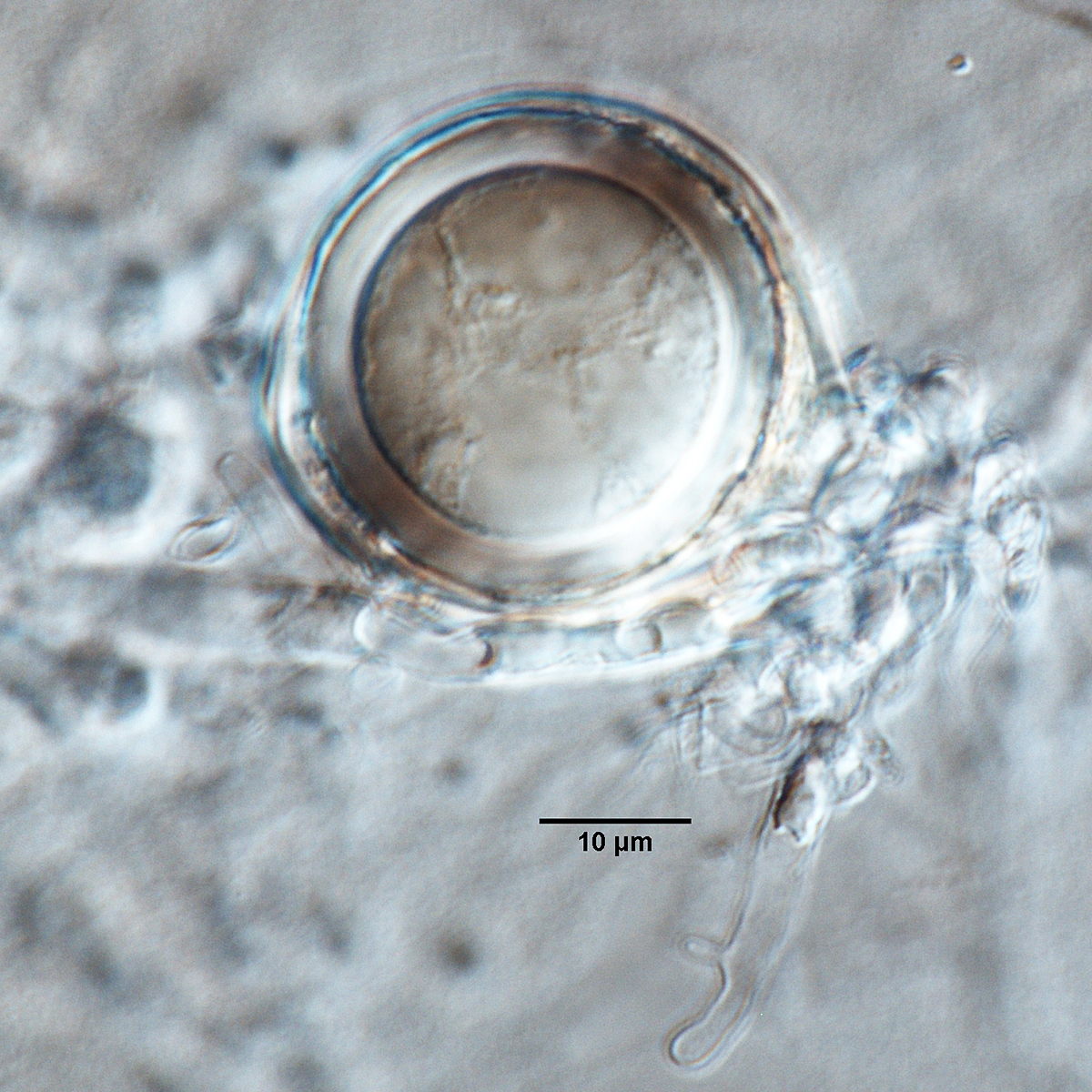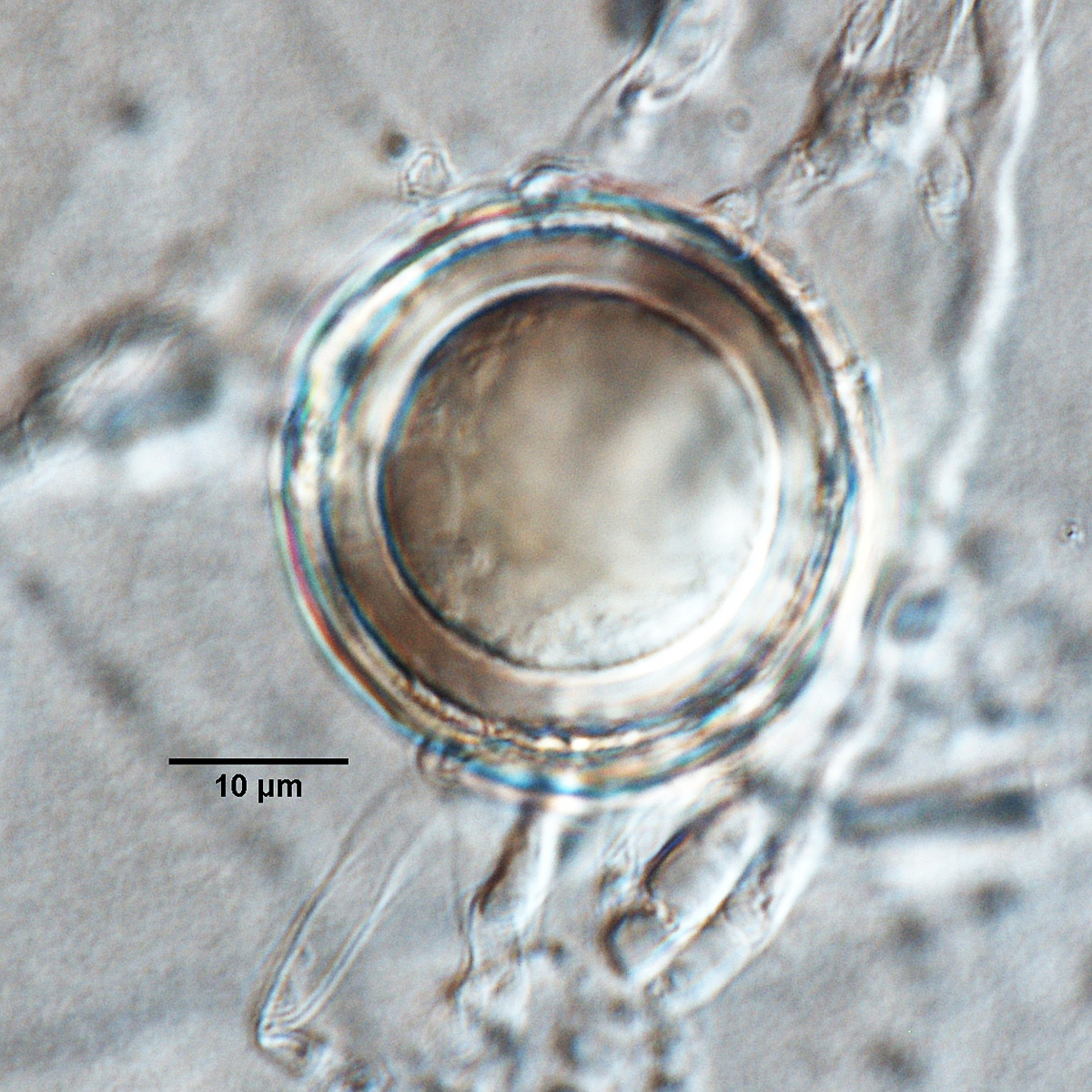Phytophthora quercina
|
Phytophthora spp. in Clade 12: portion of the seven-loci ML phylogeny featuring the type cultures of 212 described species (by T. Bourret). Notice the position of P. quercina Ex-type CBS 784.95 = S&T BL 110. Gloria Abad, USDA S&T.
|
|
Phytophthora spp. in Clade 12: Morphological Tabular key (PDF) and Tabular key legends (PDF) in IDphy2 KEY SECTION. Notice the data of P. quercina Ex-type CBS 784.95 = S&T BL 110. Gloria Abad, USDA S&T.
|
|
Phytophthora quercina (CPHST BL 110) colony of the ex-type grown for 7 days on (a) V8 agar (b) potato dextrose agar (c) malt extract agar; photos by Krysta Jennings and Leandra Knight, USDA-APHIS-PPQ |
|
Phytophthora quercina (ex-type CPHST BL 110) asexual and sexual phases (a), asexual phase (b–h): (b–e) papillate persistent sporangia originated in unbranched sporangiophores, (b) globose, (c) ovoid, (d) obpyriform, (d–f) with elongated necks; photos by Gloria Abad, USDA-APHIS-PPQ. |
|
Phytophthora quercina (ex-type CPHST BL 110) sexual phase: (a–g) smooth-walled oogonia with aplerotic golden yellow oospores, (a) with paragynous antheridia, (a, b, d) abundant mycelia close to the gametangia, and (e–g) with elongated oogonia (typical for the species); photos by Gloria Abad, USDA-APHIS-PPQ. |
|
Phytophthora quercina (CPHST-BL 53G, selected specimen) asexual and sexual phase: (a, b) colony grown for 7 days in PDA and V-8 agar, (c, d) papillate sporangia, (d) with elongated neck, (e–h) smooth-walled oogonia with paragynous antheridia and plerotic oospores; photos by Gloria Abad, USDA-APHIS-PPQ. |
|
Phytophthora quercina (ex-type CPHST BL 110) asexual phase: obpyriform papillate persistent sporangium with elongated neck, originated in unbranched sporangiophore; photo by Gloria Abad, USDA-APHIS-PPQ. |
|
Phytophthora quercina (ex-type CPHST BL 110) asexual phase: globose papillate persistent sporangium originated in unbranched sporangiophore; photo by Gloria Abad, USDA-APHIS-PPQ. |
|
Phytophthora quercina (ex-type CPHST BL 110) asexual phase: persistent sporangium with elongated neck; photo by Gloria Abad, USDA-APHIS-PPQ. |
|
Phytophthora quercina (ex-type CPHST BL 110) asexual and sexual phases: oospores and persistent sporangia; photo by Gloria Abad, USDA-APHIS-PPQ. |
|
Phytophthora quercina (ex-type CPHST BL 110) asexual phase: irregular shaped sporangium, originated in unbranched sporangiophore; photo by Gloria Abad, USDA-APHIS-PPQ. |
|
Phytophthora quercina (ex-type CPHST BL 110) asexual phase: papillate persistent sporangium with elongated neck, originated in unbranched sporangiophore; photo by Gloria Abad, USDA-APHIS-PPQ. |
|
Phytophthora quercina (ex-type CPHST BL 110) asexual phase: ovoid papillate persistent sporangium originated in unbranched sporangiophore; photo by Gloria Abad, USDA-APHIS-PPQ. |
|
Phytophthora quercina (ex-type CPHST BL 110) typical elongated oogonium with aplerotic golden yellow oospore and paragynous antheridium; photo by Gloria Abad, USDA-APHIS-PPQ. |
|
Phytophthora quercina (ex-type CPHST BL 110) typical elongated oogonium with aplerotic golden yellow oospore and paragynous antheridium; photo by Gloria Abad, USDA-APHIS-PPQ. |
|
Phytophthora quercina (ex-type CPHST BL 110) sexual phase: smooth-walled oogonium with aplerotic golden yellow oospore and abundant mycelia close to the gametangia; photo by Gloria Abad, USDA-APHIS-PPQ. |
|
Phytophthora quercina (ex-type CPHST BL 110) sexual phase: smooth-walled oogonium with aplerotic golden yellow oospore, with paragynous antheridium and abundant mycelia close to the gametangia; photo by Gloria Abad, USDA-APHIS-PPQ. |
|
Phytophthora quercina (ex-type CPHST BL 110) sexual phase: smooth-walled oogonium with aplerotic golden yellow oospore and abundant mycelia close to the gametangia; photo by Gloria Abad, USDA-APHIS-PPQ. |
|
Phytophthora quercina (ex-type CPHST BL 110) sexual phase: smooth-walled oogonium with aplerotic golden yellow oospore; photo by Gloria Abad, USDA-APHIS-PPQ. |
Name and publication
Phytophthora quercina T. Jung (1999)
Jung T, Cooke DEL, Blaschke H, Duncan JM, and Oswald W. 1999. Phytophthora quercina sp. nov., causing root rot of European oaks. Mycol. Res. 103:785–798.
Nomenclature
from Jung et al. (1999)
Mycobank
Etymology
derived from its original host, Quercus spp.
Typification
Type: GERMANY, near Munich, isolated from rhizosphere soil containing necrotic roots of mature declining oak (Quercus robur L.) in Südbayern in May 1995, isolate QUE 3
Ex-type: CBS 784.95 = no. Hag 4 (= QUE 3), deposited by T. Jung LMU, Dec. 1995
Ex-type in other collections
(ET) CBS 784.95, IFB-QUE3, ATCC MYA-4084 (MCI), WPC P10439, S&T BL 110 (Abad), No. Hag 4, 30A5, p290
Molecular identification
Voucher sequences for barcoding genes (ITS rDNA and COI) of the ex-type (see Molecular protocols page)
Phytophthora quercina ex-type isolate CPHST BL 110 (= P10439 WPC) = ITS rDNA MG865578, COI MH136970
Phytophthora quercina selected specimen isolate CPHST BL 53G (= P10334 WPC) = ITS rDNA MG865579, COI MH136971
Voucher sequences for Molecular Toolbox with seven genes (ITS, β-tub, COI, EF1α, HSP90, L10, and YPT1
(see Molecular protocols page) (In Progress)
Voucher sequences for Metabarcoding High-throughput Sequencing (HTS) Technologies [Molecular Operational Taxonomic Unit (MOTU)]
(see Molecular protocols page) (In Progress)
Sequences with multiple genes for ex-type in other sources
- NCBI: Phytophthora quercina CPHST BL 110
- NCBI: Phytophthora quercina P10439
- EPPO-Q-bank: Phytophthora quercina CBS 784.95
- BOLDSYSTEMS: Phytophthora quercina (barcoding COI & ITS)
Position in multigenic phylogeny with 7 genes (ITS, β-tub, COI, EF1α, HSP90, L10, and YPT1)
Clade 12
Genome sequence
Phytophthora quercina strain ex-type ST_20190808 (= BL 110). Accession genome ASM1470610v1 reference, BioProject PRJNA640137, USDA-APHIS-PPQ-S&T (2020)
Morphological identification
adapted from Jung et al. (1999)
Colonies and cardinal temperatures
Colony colony:
assemblage of hyphae which usually develops form a single source and grows in a coordinated way
morphology on PDA, MEA with non-distinct pattern. Minimum growth temperature 3°C, optimum 21°C, and maximum 24°C.
Conditions for growth and sporulation
Sporangia produced in small numbers on solid agar and abundantly in liquid culture. OogoniaOogonia:
the female gametangium in which the oospore forms after fertilization by the antheridium
form readily in single culture.
Asexual phase
SporangiaSporangia:
sac within which zoospores form, especially when water is cooled to about 10°C below ambient temperature; in solid substrates, sporangia usually germinate by germ tubes
papillatepapillate:
pertaining to the production of a distinct papilla at the distal end of the sporangium (cf. nonpapillate and semipapillate)
or occasionally bipapillate; persistentpersistent:
pertaining to sporangia that remain attached to the sporangiophore and do not separate or detach easily (cf. caducous)
; ovoidovoid:
egg-shaped, with the widest part at the base of the sporangium and the narrow part at the apex
, obpyriformobpyriform:
inversely pear-shaped, i.e. with the widest part at the point of attachment (cf. pyriform)
, elongate, globoseglobose:
having a rounded form resembling that of a sphere
(25–61 L x 18–36 W µm) sometimes with elongated necks; no internal proliferationinternal proliferation:
internal proliferation occurs when the sporangiophore continues to grow through an empty sporangium
is observed, originated in unbranched or simple sympodial sporangiophores. Hyphal swellings globoseglobose:
having a rounded form resembling that of a sphere
, subglobose, elongate, with some radiating hyphaehyphae:
single, tubular filament of a fungal or oomycete thallus; the basic structural unit of a fungus or oomycete
, some produced individually and some in chains. ChlamydosporesChlamydospores:
an asexual spore with a thickened inner wall that is delimited from the mycelium by a septum; may be terminal or intercalary, and survives for long periods in soil
absent. Jung et al. (1999) reported the ocurrence of chlamydosporeschlamydospores:
an asexual spore with a thickened inner wall that is delimited from the mycelium by a septum; may be terminal or intercalary, and survives for long periods in soil
on MEA for some isolates.
Sexual phase
Homothallichomothallic:
pertaining to sexual reproduction that can take place within a single thallus (i.e. self-fertile, non-outcrossing) (cf. heterothallic).
. OogoniaOogonia:
the female gametangium in which the oospore forms after fertilization by the antheridium
smooth-walled, spherical, ovoidovoid:
egg-shaped, with the widest part at the base of the sporangium and the narrow part at the apex
to elongate, and ellipsoidellipsoid:
refers to a solid body that forms an ellipse in the longitudinal plane and a circle in cross section; many fungal spores are ellipsoidal or elliptic
(22–49 µm); antheridiaantheridia:
the male gametangium; a multinucleate, swollen hyphal tip affixed firmly to the wall of the female gametangium (the oogonium)
paragynousparagynous:
pertaining to the sexual stage in which the antheridium is attached to the side of the oogonium (cf. amphigynous)
, spherical, club-shaped to irregular, usually inserted near the oogonial stalk; oosporesoospores:
zygote or thick-walled spore that forms within the oogonium after fertilization by the antheridium; may be long-lived
aplerotic and some pleroticplerotic:
pertaining to an oospore that fills the oogonium (cf. aplerotic)
(17–44 µm) and thick-walled (2.5 µm). Older oosporeoospore:
zygote or thick-walled spore that forms within the oogonium after fertilization by the antheridium; may be long-lived
walls often turn golden-yellow.
Most typical characters
Phytophthora quercina is characterized by the presence of elongated, ellipsoidellipsoid:
refers to a solid body that forms an ellipse in the longitudinal plane and a circle in cross section; many fungal spores are ellipsoidal or elliptic
oogonia that contain the same shape of oosporesoospores:
zygote or thick-walled spore that forms within the oogonium after fertilization by the antheridium; may be long-lived
.
Additional specimen(s) evaluated
Phytophthora quercina ex-type CPHST BL 110, duplicate of P10439 (World Phytophthora Collection)
selected specimen CPHST BL 53G = P10334 (WPC)
Hosts and distribution
Distribution: Asia (Turkey), Europe (Germany, Hungary, Italy, Sweden); recently reported from soil under declining oak trees in USA (MO)
Substrate: roots, rhizosphere soil
Disease note: implicated in oak decline, associated with various other Phytophthora spp
Host: Quercus spp. (Fagaceae)
Retrieved February 01, 2018 from U.S. National Fungus Collections Nomenclature Database.
Quarantine status
USA: This species was listed as a species of concern during the 2009 Phytophthora prioritization project conducted by USDA APHIS PPQ CPHST PERAL (Schwartzburg et al.).
Phytophthora quercina is also listed in the U.S. Regulated Plant Pest Table (last modified Nov. 15, 2017).
EU: no EU status; council directive 01.13.2010 (Q-bank, June 2018)
EPPO: no EPPO status, version 09.30.2011 (Q-bank, June 2018)
Additional references and links
Cooke DE, Jung T, Williams N, Shubbert R, Bahweg G, Oûwald W, and Duncan JM. 1999. Molecular evidence supports Phytophthora quercina as a distinct species. Mycol. Res. 103: 799–804.
- SMML USDA-ARS: Phytophthora quercina
- EPPO Global Database: Phytophthora quercina
- Forest Phytophthoras of the world: Phytophthora quercina
- CABI Digital Library: Phytophthora quercina
- Encyclopedia of Life (EOL): Phytophthora quercina
- Index Fungorum (IF): Phytophthora quercina
- Google All Phytophthora quercina
- Google Images Phytophthora quercina
- Google Scholar Phytophthora quercina
Fact sheet author
Z. Gloria Abad, Ph.D., USDA-APHIS-PPQ-S&T Plant Pathogen Confirmatory Diagnostics Laboratory (PPCDL), United States of America.



